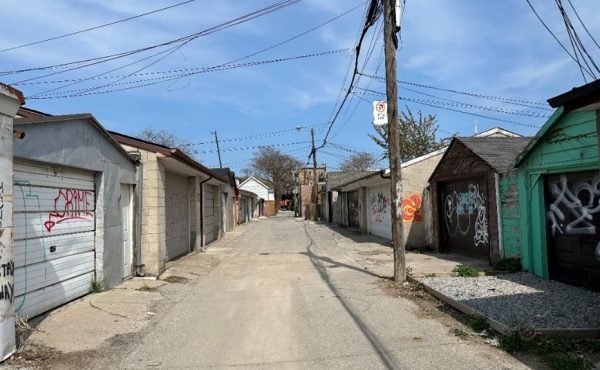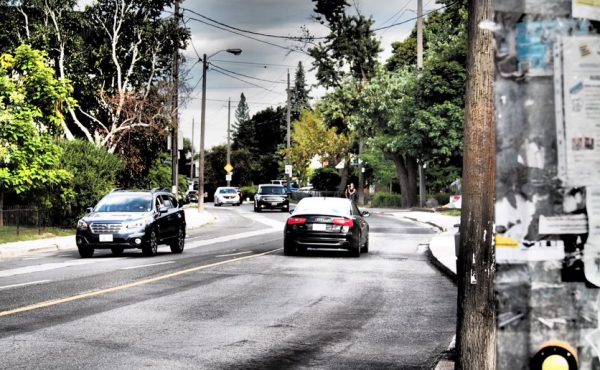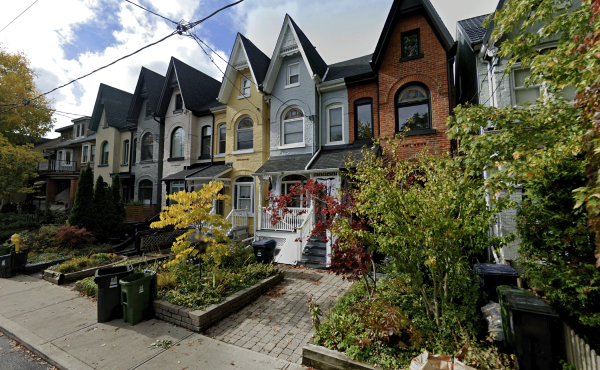
Halloween is my favourite holiday for many reasons. On top of loving to dress up each year, a big reason is it’s the holiday most dependent on how we design and build our communities.
In city planning and design, there’s an old saying about the “Trick-or-Treat Test.” It’s often brought up in the context in suburban home design: Can kids easily find the front door to your house, or must they poke behind the huge multi-car garage, past the parking asphalt, to ring your bell?
Homes that fail this Trick-or-Treat Test aren’t exactly welcoming, and not just on Halloween. Many such homes seem to be designed to have poor relationships to the street, and the neighbourhood beyond, year-round. Perhaps it’s just that the size and location of the garage is seen as more important to the house design than the front door – but what does that say about our community’s values?
A Halloween-friendly ‘hood though is more than just front door-design. Is your neighbourhood a great place for kids to get a big candy haul on Halloween night? How quickly, easily and safely can kids move from house to house? Do parents actually drive from other communities to yours, because it’s a more fruitful candy-collecting location?
When it comes to Halloween efficiency, kids are very smart, and read communities well. They know the streets where the doors are close together and well-lit, what you might call “Halloween Door Density.” When it comes to street design and traffic levels, they know where they can criss-cross quickly and reasonably safely if they need to – although kids are always reminded how unsafe that is, and not to do it! What if, though, our streets were designed in a way where this natural kid strategy WAS safe?
Great neighbourhoods for trick-or-treating also tend to be great neighborhoods for families everyday:
- Tree-lined streets designed for walkers more than speeding cars.
- Enough density and community completeness, to activate what I call “the power of nearness” – everything you need, nearby.
- Good visual surveillance through doors and stoops, windows (and I don’t mean windows in garages), porches and “eyes on the street.”
- Connected, legible streets that let you “read” the neighbourhood easily -grids tend to be good for this, but other patterns work too.
All of these are great for trick-or-treating, and equally great for walkable, healthy, economically resilient communities year-round.
At the same time, the number of kids running around on Halloween night can also tell you something. Kids are often said to be an “indicator species” for great neighbourhoods. Kids in costumes on Halloween night are an indicator too, although it can be hard to tell whether they’ve been driven in from elsewhere!
If kids ARE being driven in, that can mean it’s a great neighbourhood from a design perspective (or perhaps just that it’s a more affluent community, with “better candy”) – but having too few local kids can show that there isn’t enough housing diversity, new infill, and family-friendly “infrastructure” to keep kids in the neighbourhood. In fact, in many beautiful, tree-lined neighbourhoods popular on Halloween, the number of local kids may be actually dropping, with resulting pressures on local schools to close. This as household sizes decrease, and new density and “gentle infill” that could stabilize the population and keep kids in the neighbourhood, is often locally resisted.
But back to the suburbs — are suburban communities as bad trick-or- treating grounds as some urbanists think? The answer depends in large part on how well-designed and dense they are. Not all suburbs are “sprawl,” with separated, low-density, garage-dominated landscapes — but too many are.
Many suburbs have plenty of kids, many of which will brave even those houses that miserably fail the Trick-or-Treat Test to get their candy. The neighbourhood pattern sure doesn’t help, though, for reasons that are obvious – simply think about the opposite of all the factors discussed earlier in this article.
This has led in recent decades to trends like suburban shopping malls giving out candy, advertising themselves as the replacement for suburban streets and neighbourhoods, with warm, well-lit, unslippery, safe trick-or-treating environments. A depressing indicator of the failure of the communities themselves, or just an indication of the busy, often fear-driven lives of North American families?
Even perhaps more depressing is the “trunk-or-treat” trend, described by “Wiki Answers” like this:
Picture this: a huge parking lot with the back ends of vans and trucks decorated in a variety of fun themes; complete with games and treats. From babies on up to grandpas and grandmas, there is something for everyone. What a fun way to spend the evening as a family!
In many communities, churches sponsor the fun event and families plan their own theme for their vehicle. Sometimes elementary schools, sororities, and large neighborhoods sponsor one as well. The best part of Trunk-or-Treating is that the parking lot is roped off, freeing kids to skip or stroll from place to place.
Thankfully, walkable communities are seeing a significant rise in market share, while car-oriented developments emphasizing “malls n’ trunks” are losing favour. Walkability is now seen as key for real estate premiums – as experts like Chris Leinberger indicate, drivable neighbourhoods have been overbuilt in recent decades, while there’s been a strong pent-up demand for walkable, well-designed, “complete” communities.
When it comes to trick-or-treating, walkable communities never fell out of favour. Even in higher density building forms like mid-rises or high-rise towers, if there are front doors along the street rather than blank walls and landscaping, good trick-or-treating is possible.
Here in Vancouver, our walkable streetscapes “by design,” our “podium townhouses,” or more recently our homes with front doors on the street at the base of mid and high-rises, make trick-or-treating a viable option in even the highest densities. Now if only kids could go from floor to floor easily in higher buildings! That’s Door Density!
The powerful real estate tool WalkScore, which measures a neighbourhood’s walkability (and increasingly links it to real estate value) recently ranked America’s most Halloween-friendly cities. Their ranking shows what we already knew. Cities that are essentially walkable, pass any Trick-or-Treat Test. They are also more resilient, flexible, healthy, green, and economically successful neighbourhoods and cities.
Why is Halloween my favourite holiday? Because it reminds us once a year what great neighbourhoods are made of.
Photos by: Susy Morris (top), Penny Pengrin, and Brent Toderian
![]()
Brent Toderian is a city planner + urbanist with TODERIAN UrbanWORKS, the former chief planner for the City of Vancouver (2006-12), and the president of the Council for Canadian Urbanism. Brent contributes regularly to Spacing’s blog network.






